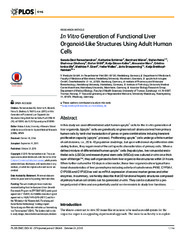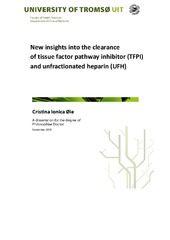Blar i forfatter "Øie, Cristina Ionica"
-
Asialoglycoprotein Receptor (ASGP-R) is Liver Parenchymal Cells is Involved in Elimination of Recombinant Human TFPI
Appa, Rupa Shree; Øie, Cristina Ionica; Brodin, Ellen; Hansen, John-Bjarne; Smedsrød, Bård (Journal article; Tidsskriftartikkel, 2010)We here report on a study carried out to determine the early clearance kinetics, and organ, cell(s) and receptor(s) responsible for the clearance of full length TFPI purified from BHK cells (TFPI<sup>BHK</sup>). Following intravenous administration, <sup>125</sup>I-TFPI<sup>BHK</sup> was cleared with a biphasic elimination curve, and with a significantly slower t<sub>1/2</sub>α compared to recombinant ... -
Chip Based Nanoscopy: Towards Integration and High-throughput Imaging
Ahluwalia, Balpreet Singh; Coucheron, David Andre; Helle, Øystein Ivar; Øie, Cristina Ionica; Dullo, Firehun Tsige (Journal article; Tidsskriftartikkel; Peer reviewed, 2017)Super-resolution optical microscopy, commonly referred to as optical nanoscopy, has enabled imaging of biological samples with a resolution that was only achievable previously using electron microscopy. Optical nanoscopy is a rapidly growing field, with several different techniques and implementations that overcome the diffraction limit of light. However, the common nanoscope continues to be a rather ... -
Chip-based optical microscopy for imaging membrane sieve plates of liver scavenger cells
Helle, Øystein Ivar; Øie, Cristina Ionica; McCourt, Peter Anthony; Ahluwalia, Balpreet Singh (Journal article; Tidsskriftartikkel; Peer reviewed, 2015-08-26)The evanescent field on top of optical waveguides is used to image membrane network and sieve-plates of liver endothelial cells. In waveguide excitation, the evanescent field is dominant only near the surface (~100-150 nm) providing a default optical sectioning by illuminating fluorophores in close proximity to the surface and thus benefiting higher signal-to-noise ratio. The sieve plates of liver ... -
Chip-based wide field-of-view nanoscopy
Ahluwalia, Balpreet Singh; Helle, Øystein Ivar; Diekmann, Robin; Øie, Cristina Ionica; McCourt, Peter A. G.; Schuttpelz, Mark (Journal article; Tidsskriftartikkel; Peer reviewed, 2017-04-24)Present optical nanoscopy techniques use a complex microscope for imaging and a simple glass slide to hold the sample. Here, we demonstrate the inverse: the use of a complex, but mass-producible optical chip, which hosts the sample and provides a waveguide for the illumination source, and a standard low-cost microscope to acquire super-resolved images via two different approaches. Waveguides composed ... -
Effect of Unfractionated Heparin on TFPI Elimination
Øie, Cristina Ionica; Appa, Rupa Shree; Brodin, Ellen; Hilden, Ida; Smedsrød, Bård; Hansen, John-Bjarne (Journal article; Tidsskriftartikkel, 2010)Background: Tissue factor pathway inhibitor (TFPI) plays an important role for the anticoagulant effect of heparin. Depletion of intravascular TFPI by treatment with unfractionated heparin (UFH), and not by low molecular weight heparin (LMWH), has been suggested to explain the superiority of LMWH in treatment of both arterial and venous thrombosis. The present study was undertaken to investigate ... -
FITC conjugation markedly enhances hepatic clearance of N-formyl peptides
Øie, Cristina Ionica; Snapkov, Igor; Elvevold, Kjetil; Sveinbjørnsson, Baldur; Smedsrød, Bård (Journal article; Tidsskriftartikkel; Peer reviewed, 2016-08-05)In both septic and aseptic inflammation, N-formyl peptides may enter the circulation and induce a systemic inflammatory response syndrome similar to that observed during septic shock. The inflammatory response is brought about by the binding of N-formyl peptide to formyl peptide receptors (FPRs), specific signaling receptors expressed on myeloid as well as non-myeloid cells involved in the ... -
Genome-wide analysis of DNA methylation and gene Expression patterns in purified, uncultures human liver cells and activated hepatic stellate cells
Taghdouini, Adil El; Sørensen, Anita Løvstad; Reiner, Andrew Henry; Coll, Mar; Verhulst, Stefaan; Mannaerts, Inge; Øie, Cristina Ionica; Smedsrød, Bård; Najimi, Mustapha; Sokal, Etienne; Luttun, Aernout; Sancho-Bru, Pau; Collas, Philippe; Grunsven, Leo A van (Journal article; Tidsskriftartikkel; Peer reviewed, 2015-08-31)<p>Background & Aims: Liver fibrogenesis – scarring of the liver that can lead to cirrhosis and liver cancer – is characterized by hepatocyte impairment, capillarization of liver sinusoidal endothelial cells (LSECs) and hepatic stellate cell (HSC) activation. To date, the molecular determinants of a healthy human liver cell phenotype remain largely uncharacterized. Here, we assess the transcriptome ... -
High-affinity von Willebrand factor binding does not affect the anatomical or hepatocellular distribution of factor VIII in rats
Øie, Cristina Ionica; Roepstorff, Kirstine; Behrens, Carsten; Bøggild Kristensen, Jesper; Karpf, Ditte Maria; Bolt, Gert; Gudme, Charlotte N.; Kjalke, Marianne; Smedsrød, Bård; Appa, Rupa Shree (Journal article; Tidsskriftartikkel; Peer reviewed, 2016-07-05)Background: Von Willebrand factor (VWF) stabilizes factor VIII in the circulation and prevents its premature clearance.<p><p> Objective: To study the effects of VWF on FVIII clearance in rats with endogenous VWF.<p><p> Methods: Anatomical and hepatocellular distribution studies were performed in rats following intravenous administration of glycoiodinated recombinant FVIII (rFVIII) and a ... -
High-Throughput Total Internal Reflection Fluorescence and Direct Stochastic Optical Reconstruction Microscopy Using a Photonic Chip
Coucheron, David Andre; Helle, Øystein Ivar; Øie, Cristina Ionica; Tinguely, Jean-Claude; Ahluwalia, Balpreet Singh (Journal article; Tidsskriftartikkel; Peer reviewed, 2019-11-16)Total internal reflection fluorescence (TIRF) is commonly used in single molecule localization based super-resolution microscopy as it gives enhanced contrast due to optical sectioning. The conventional approach is to use high numerical aperture microscope TIRF objectives for both excitation and collection, severely limiting the field of view and throughput. We present a novel approach to generating ... -
In vitro generation of functional liver organoid-like structures using adult human cells
Ramachandran, Sarada Devi; Schirmer, Katharina; Münst, Bernhard; Heinz, Stefan; Ghafoory, Shahrouz; Wölfl, Stefan; Simon-Keller, Katja; Marx, Alexander; Øie, Cristina Ionica; Ebert, Matthias P.; Walles, Heike; Braspenning, Joris; Breitkopf-Heinlein, Katja (Journal article; Tidsskriftartikkel; Peer reviewed, 2015-10-21)In this study we used differentiated adult human upcyte1 cells for the in vitro generation of liver organoids. Upcyte1 cells are genetically engineered cell strains derived from primary human cells by lenti-viral transduction of genes or gene combinations inducing transient proliferation capacity (upcyte1 process). Proliferating upcyte1 cells undergo a finite number of cell divisions, i.e., ... -
The influence of oxygen tension on the structure and function of isolated liver sinusoidal endothelial cells
Martinez, Inigo Zubiavrre; Warren, A; Le Couteur, D.G.; Nedredal, Geir Ivar; Øie, Cristina Ionica; Johansen, oddmund; Smedsrød, Bård (Journal article; Tidsskriftartikkel; Peer reviewed, 2008) -
Liver sinusoidal endothelial cells contribute to the uptake and degradation of entero bacterial viruses
Øie, Cristina Ionica; Wolfson, Deanna; Yasunori, Tanji; Dumitriu, Gianina; Sørensen, Karen Kristine; McCourt, Peter Anthony; Ahluwalia, Balpreet Singh; Smedsrød, Bård (Journal article; Tidsskriftartikkel; Peer reviewed, 2020-01-21)The liver is constantly exposed to dietary antigens, viruses, and bacterial products with inflammatory potential. For decades cellular uptake of virus has been studied in connection with infection, while the few studies designed to look into clearance mechanisms focused mainly on the role of macrophages. In recent years, attention has been directed towards the liver sinusoidal endothelial cells ... -
Multi-color imaging of sub-mitochondrial structures in living cells using structured illumination microscopy
Opstad, Ida Sundvor; Wolfson, Deanna; Øie, Cristina Ionica; Ahluwalia, Balpreet Singh (Journal article; Tidsskriftartikkel; Peer reviewed, 2018-05-18)The dimensions of mitochondria are close to the diffraction limit of conventional light microscopy techniques, making the complex internal structures of mitochondria unresolvable. In recent years, new fluorescence-based optical imaging techniques have emerged, which allow for optical imaging below the conventional limit, enabling super-resolution (SR). Possibly the most promising SR and diffraction-limited ... -
Multimodal super-resolution optical microscopy visualizes the close connection between membrane and the cytoskeleton in liver sinusoidal endothelial cell fenestrations
Mönkemöller, Viola; Øie, Cristina Ionica; Hubner, Wolfgang; Huser, Thomas Rolf; McCourt, Peter Anthony (Journal article; Tidsskriftartikkel; Peer reviewed, 2015)Liver sinusoidal endothelial cells (LSECs) act as a filter between blood and the hepatocytes. LSECs are highly fenestrated cells; they contain transcellular pores with diameters between 50 to 200 nm. The small sizes of the fenestrae have so far prohibited any functional analysis with standard and advanced light microscopy techniques. Only the advent of super-resolution optical fluorescence microscopy ... -
Multiscale and Multimodal Optical Imaging of the Ultrastructure of Human Liver Biopsies
Kong, Cihang; Bobe, Stefanie; Pilger, Christian; Lachetta, Mario; Øie, Cristina Ionica; Kirschnick, Nils; Mönkemöller, Viola; Hübner, Wolfgang; Förster, Christine; Schuttpelz, Mark; Kiefer, Friedemann; Huser, Thomas; Schulte am Esch, Jan (Journal article; Tidsskriftartikkel; Peer reviewed, 2021-02-17)The liver as the largest organ in the human body is composed of a complex macroscopic and microscopic architecture that supports its indispensable function to maintain physiological homeostasis. Optical imaging of the human liver is particularly challenging because of the need to cover length scales across 7 orders of magnitude (from the centimeter scale to the nanometer scale) in order to fully ... -
Nanoscopy on-a-chip: super-resolution imaging on the millimeter scale
Helle, Øystein Ivar; Coucheron, David Andre; Øie, Cristina Ionica; Ahluwalia, Balpreet Singh (Journal article; Tidsskriftartikkel; Peer reviewed, 2019-03-04)Optical nanoscopy techniques can image intracellular structures with high specificity at sub-diffraction limited resolution, bridging the resolution gap between optical microscopy and electron microscopy. So far conventional nanoscopy lacks the ability to generate high throughput data, as the imaged region is small. Photonic chip-based nanoscopy has demonstrated the potential for imaging large areas, ... -
New insights into the clearance of tissue factor pathway inhibitor (TFPI) and unfractionated heparin (UFH)
Øie, Cristina Ionica (Doctoral thesis; Doktorgradsavhandling, 2010-11-05)”Hvor mye?”, ”Hvor ofte?” og ”Hvor lenge?” er sentrale spørsmål i studier av legemidler. For å finne en optimal behandling trenger man kunnskap om et legemiddels opptak, fordeling i kroppen, og nedbryting. Øie sitt prosjekt viser at leveren spiller en nøkkelrolle i nedbrytningen av to sentrale substanser som hemmer blodlevring (antikoagulantia), heparin og tissue factor pathway inhibitor (TFPI). ... -
New ways of looking at very small holes – using optical nanoscopy to visualize liver sinusoidal endothelial cell fenestrations
Øie, Cristina Ionica; Mönkemöller, Viola; Hübner, Wolfgang; Schüttpelz, Mark; Mao, Hong; Ahluwalia, Balpreet Singh; Huser, Thomas Rolf; McCourt, Peter Anthony (Journal article; Tidsskriftartikkel; Peer reviewed, 2018-01-10)Super-resolution fluorescence microscopy, also known as nanoscopy, has provided us with a glimpse of future impacts on cell biology. Far-field optical nanoscopy allows, for the first time, the study of sub-cellular nanoscale biological structures in living cells, which in the past was limited to electron microscopy (EM) (in fixed/dehydrated) cells or tissues. Nanoscopy has particular utility in the ... -
Photonic-chip assisted correlative light and electron microscopy
Tinguely, Jean-Claude; Steyer, Anna Maria; Øie, Cristina Ionica; Helle, Øystein Ivar; Dullo, Firehun Tsige; Olsen, Randi; McCourt, Peter; Schwab, Yannick; Ahluwalia, Balpreet Singh (Journal article; Tidsskriftartikkel; Peer reviewed, 2020-12-07)Correlative light and electron microscopy (CLEM) unifies the versatility of light microscopy (LM) with the high resolution of electron microscopy (EM), allowing one to zoom into the complex organization of cells. Here, we introduce photonic chip assisted CLEM, enabling multi-modal total internal reflection fluorescence (TIRF) microscopy over large field of view and high precision localization of the ... -
Primary rat LSECs preserve their characteristic phenotype after cryopreservation
Mönkemöller, Viola; Mao, Hong; Hubner, Wolfgang; Heimann, Peter; Levy, Gahl; Huser, Thomas; Kaltschmidt, Barbara; Kaltschmidt, Christian; Øie, Cristina Ionica (Journal article; Tidsskriftartikkel; Peer reviewed, 2018-10-02)Liver disease is a leading cause of morbidity and mortality worldwide. Recently, the liver non-parenchymal cells have gained increasing attention for their potential role in the development of liver disease. Liver sinusoidal endothelial cells (LSECs), a specialized type of endothelial cells that have unique morphology and function, play a fundamental role in maintaining liver homeostasis. Current ...


 English
English norsk
norsk


















